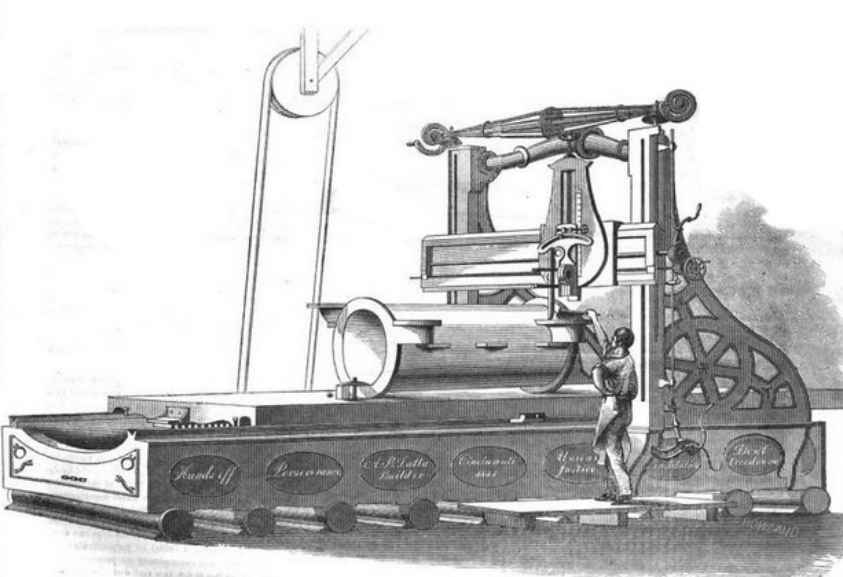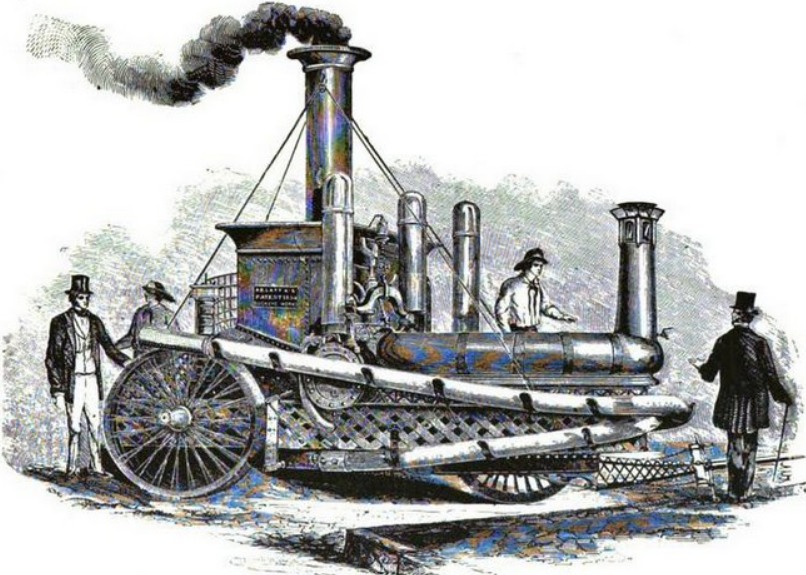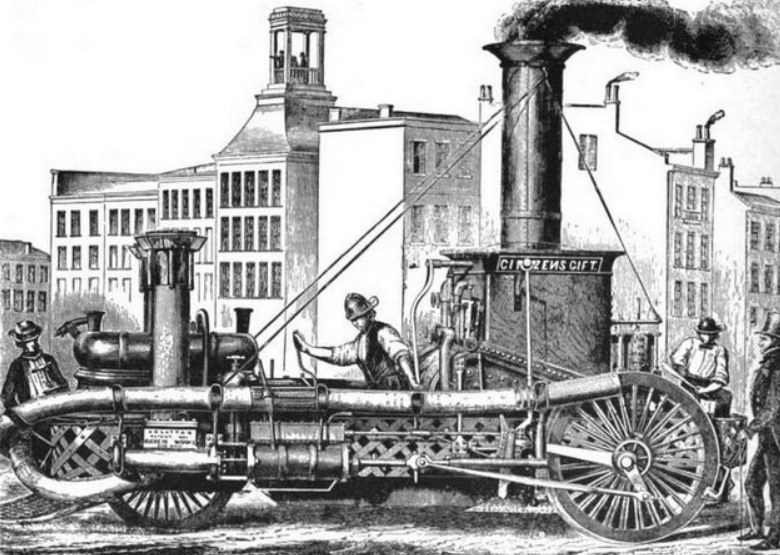
| Version | Summary | Created by | Modification | Content Size | Created at | Operation |
|---|---|---|---|---|---|---|
| 1 | Catherine Yang | -- | 989 | 2022-12-08 06:08:19 |
Video Upload Options
1. Introduction
Alexander Bonner Latta (June 11, 1821 – April 28, 1865) was an American manufacturer and inventor. He produced the first practical steam fire engine that was successfully used as a routine part of a city's fire department equipment.
2. Early Life
Latta was born on a farm just outside the city limits of Chillicothe, Ohio, on July 11, 1821.[1] He was the youngest of six children and went by the nickname "Moses". When five years old his father, John Latta, was killed in an accident. This left his mother, Rebecca Latta, a penniless widow. Latta started schooling and attended a country school in Ohio until he was thirteen years old.[2] He was forced to quit school to help support his mother and brothers and worked at a cotton factory woolen mill for seventy-five cents per week. Three years later he worked at a shipyard, starting at three dollars per week. Three years later he then went to work at a brass foundry.[2] He worked much with machinery and became a mechanic.[3] His mother then moved the family to Cincinnati in the early 1840s for better financial opportunities.[4]
3. Mid Life and Career

Latta's first jobs were for David Bradford Woolen Mills, Samuel Cummings' brass foundry, and William Bylad's machine shop.[5] Latta met Anthony Harkness, owner of a foundry and machine shop in Cincinnati, while on a business trip to Washington, D. C. in 1841. He explained to Harkness his mechanical ability and about his invention for a machine that would make parts for steamboat paddle wheels. He made such an impression on Harkness that he was offered a job as a superintendent of Harkness's foundry.[3] His first assignment was that of designing a huge lathe and planing machine for Harkness.[6] The inventor George Escol Sellers believed the planing machine was a mechanical masterpiece.[7]
Latta first became a foreman at the Harkness machine shop and later became an engineer. In 1845 he directed the construction of the first railroad locomotive built west of the Alleghany Mountains.[8] He was the train engineer that made the trial round trip from Cincinnati to Columbus, Ohio.[4] Latta designed in 1846 an unusual train locomotive for the Boston and Maine Railroad. It had an additional set of cylinders built under the water tank which took the steam exhaust back forward through specially designed pipes that allowed the steam energy to be used again.[9]
4. Family
Latta married Elizabeth Ann Pawson October 21, 1847. They had two children who grew to adulthood, G. Taylor and Luella M. Latta.[2]
5. Uncle Joe Ross and Citizen's Gift Steam Fire Engines


Latta's greatest inventions were those related to steam fire engines. He made his first one in 1852 and it was purchased by the City of Cincinnati to incorporate as part of its fire department equipment. His first manufactured steam fire engines could be drawn by both men and horses. In 1855 he was granted a patent on a self-propelled steam engine.[8] It consisted of three steel wheels and designed like a tricycle. The front wheel was for steering and the back wheels not only propelled the machine down the streets, but powered the pumps to push the water through the hoses. The boiler was of two square chambers, one within the other. The space between them contained water that was heated to steam by the inner chamber firebox.[9]
Latta invented the first successful steam fire engine in the world that was practical and used by a city fire department as part of their equipment.[10][11][12][13][14] The steam fire engine was named Uncle Joe Ross for Joseph Ross, after the councilman that promoted it.[15] Latta designed his steam fire engine in 1852.[16][17] The steam fire engine was put into full service at the Cincinnati fire department on January 1, 1853, and used as a regular part of their equipment for putting out fires.[12][18] The Cincinnati volunteer fire department was reorganized in April 1853, because of Latta's practical steam fire engine that they were using successfully to put out fires. The Cincinnati fire department officially became the first paid company of firemen.[19] The city ordered another of Latta's practical steam fire engines in 1854 and it was named Citizen's Gift, since the money to purchase it came from the citizens of Cincinnati.[13][20] Boston was the next to adopt Latta's practical steam fire engine, followed by New York City, and then other cities.[15][21]
The steam fire engine Uncle Joe Ross was demonstrated in a test in 1855 when it exploded.[22] This was the first steam fire engine explosion.[23] It injured several people and killed the operating engineer.[23] The damaged fire engine was replaced by the Citizen's Gift and the A.B.Latta fire engines, that the citizens of Cincinnati purchased from Latta for $9,500 each and were delivered before the end of the year.[15]
6. Later Life and Death


Latta invented several improvements to steam locomotives and fire engines that he patented between 1847 and his death.[9] He formed the company Buckeye Works in 1846 with his brothers Edmundson and Finlay.[1] He had built 30 steam locomotive engines by 1860.[24]
Latta's last design was of a "steam dummy" for the street railway in the city of Cincinnati. It consisted of his 6-horsepower portable engine that was built into a street railway car and tested in March 1860.[1]
Latta retired in 1862 and died in Ludlow, Kentucky, in 1865.[8]
7. Awards
Latta invented a series of improvements in railroad applications, but only a few of his patented inventions were actually used in the industry.[25] He received a gold medal for fire engine improvements at the Ohio Mechanics Institute Fair in 1854.[26]
References
- White 1965, p. 11.
- Jones 1881, p. 195.
- Tenkotte 2015, p. 539.
- Malone 1934, p. 28.
- Rhode 2008, p. 140.
- McGraw-Hill 1889, p. 15.
- Rhode 2008, p. 141.
- Marquis 1967, p. 375.
- Malone 1934, p. 29.
- Tenkotte 2015, p. 573.
- King 1896, p. 13.
- Kane 1997, p. 272.
- "Cincinnati Fire Department". Ohio History Connection. 2017. http://www.ohiohistorycentral.org/w/Cincinnati_Fire_Department. "The fire engine was presented to the Cincinnati Fire Department on January 1, 1853, making Cincinnati the first city in the world to use steam fire engines. This first engine was named "Uncle Joe Ross" after a city council member. In 1854, Cincinnati residents raised enough funds to allow the Fire department to purchase a second steam fire engine. This engine was known as "Citizen's Gift.""
- "Fire Department History". City of Cincinnati. 2017. http://www.cincinnati-oh.gov/fire/history/.
- "First Steam Fire Engine in 1853 – Cincinnati gave it to the world and Boston was the next to adopted it.". The Gazette Times (Pittsburgh, Pennsylvania). October 15, 1911. https://www.newspapers.com/clip/9759997//. "The first successful steam fire engine was invented by Moses Latta of Cincinnati and constructed by his brothers, proprietors of a machine shop in that city. Latta started work on the new engine in March 1852. Its first trial took place on New Year's Day, 1853. It was a success and went into commission on that day."
- "How Steam Blew Rowdies out of the fire department". The Daily Standard (Sikeston, Missouri): p. 6. March 2, 1959. https://www.newspapers.com/clip/9760213/the_daily_standard/.
- McGraw-Hill 1890, p. 16.
- "First Fire Engine Ever Built – The UNCLE JOE ROSS in action in Cincinnati / Cincinnati gave it to the World and other cities adopted it". The Washington Post (Washington, District of Columbia): p. 46. October 15, 1911. https://www.newspapers.com/clip/10240887/.
- "History of the Steam fire Engine – first fire-engine ever built, the Uncle Joe Ross in action – Cincinnati gave it to the World and other cities adopted it". The Washington Post (Washington, District of Columbia): p. 2. October 15, 1911. https://www.newspapers.com/clip/9759742//.
- "A Paid Fire Department – The experience of other cities – The Steam Fire Engine – The paid and voluntary systems compared". The Brooklyn Daily Eagle -page 2 (Brooklyn, New York). April 3, 1858. https://www.newspapers.com/clip/10231649/.
- "The Fire Engine – Account of the Invention of the First Steam Fire Engine – The Work of Moses Latta, a stunted being with a wondrous head – incidents of its first appearance". The Saint Paul Globe (Saint Paul, Minnesota): p. 8. January 1, 1884. https://www.newspapers.com/clip/9762072/the_saint_paul_globe/.
- "Explosion of the "Uncle Joe Ross" Steam Engine Explosion Kills John Winterbottom 5 December 1855". Cincinnati Fire Department history. May 3, 2015. http://cincyfirehistory.blogspot.com/2015/05/explosion-of-uncle-joe-ross.html. Retrieved April 9, 2017.
- "The Explosion of a Steam Fire Engine at Cincinnati". The Wheeling Daily Intelligencer-page 3 (Wheeling, West Virginia). December 11, 1855. https://www.newspapers.com/clip/10093296/.
- Wartenberg, George (March 23, 1969). "The Queen City – The Locomotive Builder". Cincinnati Equirer (Cincinnati, Ohio): pp. 167–170.
- Seidman, Sandra R. (September 2012), Journal of Kentucky Studies – Alexander Bonner “Moses” Latta, Nineteenth-Century Inventor and Entrepreneur, vol 29: Northern Kentucky University, p. 142, "Latta did not give up entirely his interest in building a locomotive. He held several patents for improvements including an automatic lubricator for axles and an improved wheel for steam carriages, as well as a metallic chimney to replace the glass chimney in oil lamps. In 1856, he designed a coal-burning locomotive that proved to be a total failure. Undeterred, he issued a catalog in 1857 listing improvements, but there is no evidence that a machine was ever produced. He made one last try—building a small steam locomotive, called a dummy, to be used on the new Cincinnati street railway. It was a mechanical success, but the Cincinnati Gazette of March 28, 1860, wrote that it frightened the horses so badly that it was deemed unsatisfactory for public use."
- Wilson 1887, p. 628.
Location: Unknown




